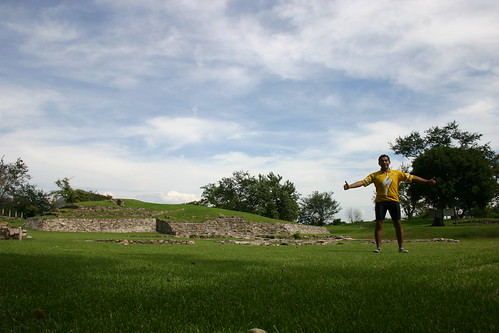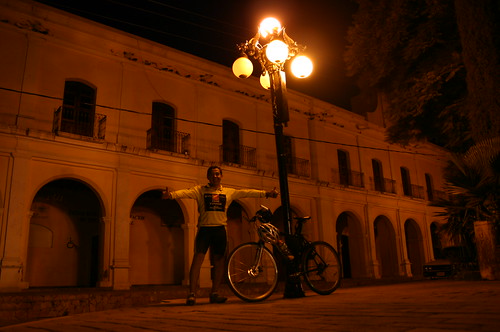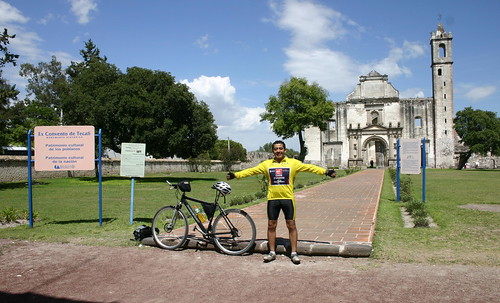Cholula Archaeological Site + Texmelucan (Puebla), 26.08.07
Photoset Map
Full Photoset Show
GPS Track: KMZ (Google Earth), or GPX (MapSource, et al).
GPS Cycling Data:



Distance: 160 Km, Total Ascent: 1302 m, Total Descent: 1260 m, Time: 06:11 hr, Avg. Speed: 24.3 Km/hr, Max Speed: 73.5 Km/hr, Energy Expended: 26.85 MJ, Power: 302 W.
Travel Report:
Thank you for reading. Till the next journey.



Distance: 160 Km, Total Ascent: 1302 m, Total Descent: 1260 m, Time: 06:11 hr, Avg. Speed: 24.3 Km/hr, Max Speed: 73.5 Km/hr, Energy Expended: 26.85 MJ, Power: 302 W.
Travel Report:
This ride started last Sunday at 08:20, almost three hours later than intended, as I had hoped to be able to start cycling at 05:30. I took my usual route to Puebla from Mexico City center: Ignacio Zaragoza Av. to the southeast of the city, in order to reach the junction between both free and toll Puebla highways in Los Reyes. By the way, this time the road was closed to all automotive traffic at the junction, so it was a pleasure cycling alone in the beginning of the free highway. In fact, I could take some surreal photographs of the building site that is now located in both highways. After that point, I continued cycling along the free highway, crossing on my way the whole county of Ixtapaluca. Once this county ends, the mountain climbing towards the Llano Grande summit (elev: 3220 m) starts after passing the town of Zoquiapan (elev: 3260 m).
As this time I was being chased by several fellow cyclists, I could not take any photos of the landscape in the ascent. But anyway, you have already seen lots of pictures of that ascent in my previous reports of that route to Puebla. From Zoquiapan, where I arrived at 09:55, I needed 90 minutes to reach the Llano Grande summit. Along that climb I was fortunate enough to see several cyclists that were already riding the return descent from the summit towards the Mexico City Valley. Once at Llano Grande, I found another cyclist that was climbing from Texmelucan (Puebla) towards the summit (i.e. from the other side of the mountain). As I, once I had crowned the port, started my descent towards Texmelucan, that fellow rider (who happened to live in Tlaxcala) and me cycled together a good part of the ride towards Texmelucan. It was surely fun to talk and ride that descent at more than 60 km/hr, simultaneously, although a little bit dangerous.
At my arrival at Texmelucan and before continuing my trip towards Cholula, I could pay a long overdue visit to the beautiful white church of St Mary Magdalene, in Texmelucan. This precious all white church is located not in the center of Texmelucan, but along the highway to Huejotzingo. I was fortunate enough to arrive at the church just when the most revered moment of the mass was taking place, so I could see how all the people in the church, including also the ones that could not enter in the shrine (as it was already full) and were standing out of the church,kneeled down at the consagration . By the way, it was also fine to note that there were several bicycles standing at the front of the church. After finishing my visit to this church, I went to the center of the city to buy another liter of isotonic drink and something to eat.
Once cycling again, I took the highway to Huejotzingo, which is a beautiful road in pristine conditions. It even features a side line for bicycles ! At my arrival at Huejotzingo, I decided not to stop there, as I had already obtained photos from its enormous and beautifully orange painted church. But when I reached the town of Santa Maria Zacatepec, I had to made a due stop, since this town houses a beautiful blue church, an impressive clock tower built with orange bricks, and a simple yet stunning big kiosk, built with the same orange bricks as the clock tower. I had previously desired several times to stop in Zacatepec on my way to Puebla, just to have a look at that impressive architectural group, but I had been unable to do that before, as the whole architectural group is located in the top of a hill, which is accessed only by stairways ... and this ascent is very difficult to perform riding a bicycle :-)
Ten kilometers or so after Zacatepec, I could finally reach Cholula, and, after crossing its main square, I could arrive at last in the Cholula Archaeological Site, which houses the largest man-made structure by volume in the world ! First of all, I had to leave my bicycle in a secure place, as I (obviously) was not going to be allowed to enter in the Great Pyramid with it.
Inside the Great Pyramid we (the visitors) could roam across a network of tunnels that travel across the pyramid's interior. You can have a look of those dramatic pictures in the photoset. The corridors inter-connect via staircases with the different levels of the interior, as there are several pyramids, one built atop the other, in the interior of that Great Pyramid.
Once outside the pyramid (and after recovering the lost sight, owed to the stark contrast with daylight), the church of Our Lady of Remedies could be seen at the top of the pyramid. It was a custom for the Spanish conquerors to built a christian church at the top of the most importantpre-Hispanic temples, and this case, sadly, was no exception.
Outside the Great Pyramid stands the adjoining Archaeological Site. This huge site comprehends several impressive pre-Hispanic buildings: a Teotihuacan building, Stone Courtyard, Altars Courtyard, Mexica Altar, Building F, Buildings 1 - 6, and an Offerings Altar. As it is said that an image is worth a thousand words, I do sincerely recommend you having a look at the extensive array of photographs taken at the site, in the above linked photoset.
When I was almost exiting the site, at the foot of the Building F (the only staircase that has been restored to its initial state) I had the opportunity to observe a magnificent spectacle: the Papantla flyers ! It is really a unique chance to observe that aerial dance !
After finishing my visit to this incredible rich site, I went for my bicycle and, after crossing the center of Cholula, and its beautiful arches and Cathedral, I started the return leg of my journey. Please note that owed to the extension of the archaeological site, it was now 17:30, so my priority was now to arrive at Texmelucan, since the whole return to Mexico City in bicycle was now impossible given the hour.
But the big problem started as soon as I was leaving Cholula: a diluvial rain started to fall ! In just some minutes the whole highway to Texmelucan had been converted into a river ! I was riding in a stream of water of half meter (yes, 50 cm) deep ! I had never cycled inside that kind of water stream. And worst of all, it was an uphill road. But it was not even a road now: the water had covered the whole road (both ways) with a stream of more than half meter of deep. As the rain continued to fall, as soon as I found a place where to take cover from the rain, I stopped my insane riding. But the water level continued to rise, facing me with the possibility that the very place where I was standing were soon covered also by water. What course of action should I take ? If I rode downhill towards Cholula I was going to face more water, but at least a big city. If I choosed to ride uphills, I could find less water, but the ride was going to be a lot harder for the slope, and the next big city (Huejotzingo) was more distant than Cholula. What should I do if this crazy rain continues ?
Fortunately, after half an hour the rain stopped as by magic, so the stream over the road stopped to rise. I decided then to continue my ride uphills, towards Huejotzingo and Texmelucan. I still had to ride inside that half meter deep water stream, but it was only in the following couple of kilometers, since as far as I continued ascending, the volume of water that I found on the road diminished with the height, up to a point where, happily, no more water stream was on the road ! I can not imagine what those kind of rains could do to human settlements if the rain would last several hours, as is the case with hurricane rains.
From that point it was a piece of cake the return to Texmelucan, although a slight rain continued, there were no more rivers on the highway. In this way I could safely arrive at Texmelucan at 19:50, where I purchased my return bus ticket (AU lines, 54 pesos fare). The bus departed at 20:10, arriving in Mexico City a couple of hours later at the TAPO bus terminal. From there a short subway trip and I was again in the safety of home, albeit wet all the way to the marrow !
As this time I was being chased by several fellow cyclists, I could not take any photos of the landscape in the ascent. But anyway, you have already seen lots of pictures of that ascent in my previous reports of that route to Puebla. From Zoquiapan, where I arrived at 09:55, I needed 90 minutes to reach the Llano Grande summit. Along that climb I was fortunate enough to see several cyclists that were already riding the return descent from the summit towards the Mexico City Valley. Once at Llano Grande, I found another cyclist that was climbing from Texmelucan (Puebla) towards the summit (i.e. from the other side of the mountain). As I, once I had crowned the port, started my descent towards Texmelucan, that fellow rider (who happened to live in Tlaxcala) and me cycled together a good part of the ride towards Texmelucan. It was surely fun to talk and ride that descent at more than 60 km/hr, simultaneously, although a little bit dangerous.
At my arrival at Texmelucan and before continuing my trip towards Cholula, I could pay a long overdue visit to the beautiful white church of St Mary Magdalene, in Texmelucan. This precious all white church is located not in the center of Texmelucan, but along the highway to Huejotzingo. I was fortunate enough to arrive at the church just when the most revered moment of the mass was taking place, so I could see how all the people in the church, including also the ones that could not enter in the shrine (as it was already full) and were standing out of the church,kneeled down at the consagration . By the way, it was also fine to note that there were several bicycles standing at the front of the church. After finishing my visit to this church, I went to the center of the city to buy another liter of isotonic drink and something to eat.
Once cycling again, I took the highway to Huejotzingo, which is a beautiful road in pristine conditions. It even features a side line for bicycles ! At my arrival at Huejotzingo, I decided not to stop there, as I had already obtained photos from its enormous and beautifully orange painted church. But when I reached the town of Santa Maria Zacatepec, I had to made a due stop, since this town houses a beautiful blue church, an impressive clock tower built with orange bricks, and a simple yet stunning big kiosk, built with the same orange bricks as the clock tower. I had previously desired several times to stop in Zacatepec on my way to Puebla, just to have a look at that impressive architectural group, but I had been unable to do that before, as the whole architectural group is located in the top of a hill, which is accessed only by stairways ... and this ascent is very difficult to perform riding a bicycle :-)
Ten kilometers or so after Zacatepec, I could finally reach Cholula, and, after crossing its main square, I could arrive at last in the Cholula Archaeological Site, which houses the largest man-made structure by volume in the world ! First of all, I had to leave my bicycle in a secure place, as I (obviously) was not going to be allowed to enter in the Great Pyramid with it.
Inside the Great Pyramid we (the visitors) could roam across a network of tunnels that travel across the pyramid's interior. You can have a look of those dramatic pictures in the photoset. The corridors inter-connect via staircases with the different levels of the interior, as there are several pyramids, one built atop the other, in the interior of that Great Pyramid.
Once outside the pyramid (and after recovering the lost sight, owed to the stark contrast with daylight), the church of Our Lady of Remedies could be seen at the top of the pyramid. It was a custom for the Spanish conquerors to built a christian church at the top of the most importantpre-Hispanic temples, and this case, sadly, was no exception.
Outside the Great Pyramid stands the adjoining Archaeological Site. This huge site comprehends several impressive pre-Hispanic buildings: a Teotihuacan building, Stone Courtyard, Altars Courtyard, Mexica Altar, Building F, Buildings 1 - 6, and an Offerings Altar. As it is said that an image is worth a thousand words, I do sincerely recommend you having a look at the extensive array of photographs taken at the site, in the above linked photoset.
When I was almost exiting the site, at the foot of the Building F (the only staircase that has been restored to its initial state) I had the opportunity to observe a magnificent spectacle: the Papantla flyers ! It is really a unique chance to observe that aerial dance !
After finishing my visit to this incredible rich site, I went for my bicycle and, after crossing the center of Cholula, and its beautiful arches and Cathedral, I started the return leg of my journey. Please note that owed to the extension of the archaeological site, it was now 17:30, so my priority was now to arrive at Texmelucan, since the whole return to Mexico City in bicycle was now impossible given the hour.
But the big problem started as soon as I was leaving Cholula: a diluvial rain started to fall ! In just some minutes the whole highway to Texmelucan had been converted into a river ! I was riding in a stream of water of half meter (yes, 50 cm) deep ! I had never cycled inside that kind of water stream. And worst of all, it was an uphill road. But it was not even a road now: the water had covered the whole road (both ways) with a stream of more than half meter of deep. As the rain continued to fall, as soon as I found a place where to take cover from the rain, I stopped my insane riding. But the water level continued to rise, facing me with the possibility that the very place where I was standing were soon covered also by water. What course of action should I take ? If I rode downhill towards Cholula I was going to face more water, but at least a big city. If I choosed to ride uphills, I could find less water, but the ride was going to be a lot harder for the slope, and the next big city (Huejotzingo) was more distant than Cholula. What should I do if this crazy rain continues ?
Fortunately, after half an hour the rain stopped as by magic, so the stream over the road stopped to rise. I decided then to continue my ride uphills, towards Huejotzingo and Texmelucan. I still had to ride inside that half meter deep water stream, but it was only in the following couple of kilometers, since as far as I continued ascending, the volume of water that I found on the road diminished with the height, up to a point where, happily, no more water stream was on the road ! I can not imagine what those kind of rains could do to human settlements if the rain would last several hours, as is the case with hurricane rains.
From that point it was a piece of cake the return to Texmelucan, although a slight rain continued, there were no more rivers on the highway. In this way I could safely arrive at Texmelucan at 19:50, where I purchased my return bus ticket (AU lines, 54 pesos fare). The bus departed at 20:10, arriving in Mexico City a couple of hours later at the TAPO bus terminal. From there a short subway trip and I was again in the safety of home, albeit wet all the way to the marrow !
Thank you for reading. Till the next journey.












